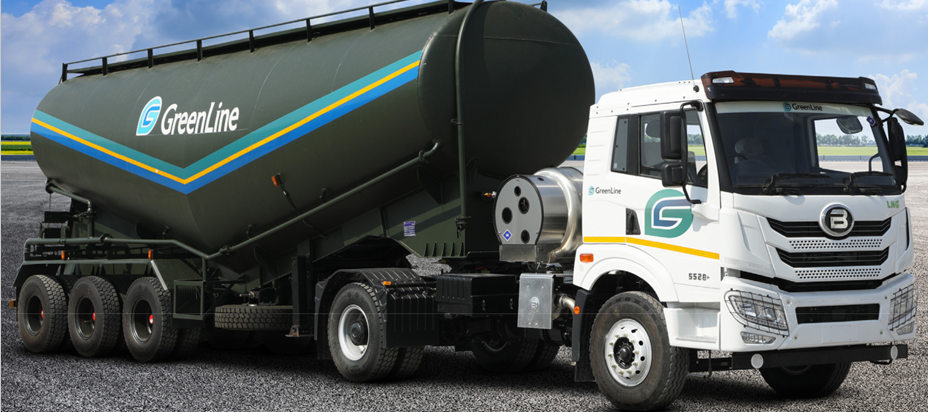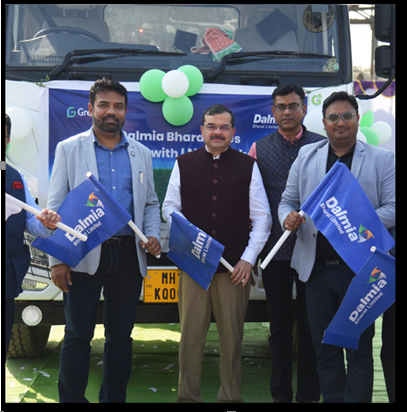By demonstrating how heavy haulage can be cleaner and greener at comparable cost economics to the existing polluting choice and how it can also offer improved control and efficiencies through use of technology, GreenLine is helping debunk the widespread idea that ‘green is expensive’, shares Anand Mimani, CEO, Green Planet Logistics (P) Ltd. in an exclusive interview with Rajesh Rajgor

Could you take us through the rationale behind establishing a clean fuel logistics company?
GreenLine was launched with the formation of Green Planet Logistics (P) Ltd. in 2021. The logistics sector is the fastest growing sector and a major contributor of global greenhouse gas emissions. In India, the logistics sector emits the third most amount of CO2 (14%), of which heavy trucking contributes 90%. In other words, heavy trucking contributes a very significant 12% of the total emissions. Reduction in these emissions can make a significant impact towards achieving the country’s COP 26 emission reduction targets.
Switching to LNG-powered trucks can significantly reduce toxic emissions compared to diesel, in terms of CO2 by up to 28%, CO by up to 70%, SOx (sulphur oxides) by up to 100%, NOx (nitrogen oxides) by up to 59% and particulate matter (PM) by up to 91%. Typically, the emissions reduction focus of industries tends to be on their core manufacturing processes while diesel-powered road logistics tends to be missed out. We at GreenLine have taken it upon ourselves to catalyse decarbonisation of heavy trucking by providing a cleaner, greener alternative to industries for their road logistics.
While LNG technology is undoubtedly an immediate solution for low carbon emissions in the long-haul logistics sector, how do you see the network of LNG pumps and their availability on national highways for you to operate efficiently?
An LNG refuelling network is critical to deployment of LNG trucking and there has been positive movement in this direction. Many private companies as well as PSUs are in the process of setting up their LNG retail outlets and have ambitious plans of creating pan-India networks of these outlets. Some of these PSU outlets are expected to be operational in Q1 of FY 2024. GreenLine has engaged with LNG refuelling infrastructure companies such as B-LNG, LNG Express and Ultra Gas and Energy. Similar conversations are underway with other organisations in this space. These engagements will enable us to align the station roll-out and create GreenLine’s footprint, thereby ensuring improved efficiencies all round.

Could you elaborate about your services?
GreenLine currently operates in two distinct business verticals that are enabling decarbonisation of the Indian economy. The first is logistics and second is the virtual pipeline. Under green logistics, we operate fleets of LNG-powered heavy-duty trucks as a cleaner, greener alternative to diesel-fuelled trucking to help our customers reduce emissions from their road logistics. This helps corporates reduce emissions from their heavy trucking without impacting their logistics deliverables. This further helps these corporates improve their ESG (environmental, social and governance) performance – a critical factor for key stakeholders of these companies.
It therefore also enables their respective journeys to achieve net zero status. Under the virtual pipeline business, we deliver natural gas in liquefied (LNG) and compressed (CNG) forms to industries in the off-gas-grid locations. This access to natural gas, the cleanest fossil fuel, enables industries to switch from conventional polluting fuels such as coal and furnace oil (FO) and significantly reduce their toxic emissions. We currently operate one of the largest privately owned fleets of LNG tanker trucks in the country. The focus at all times is to help companies reduce their emissions.
Reducing emissions from heavy trucking is crucial for corporations targeting net zero status. So how does GreenLine enable them through its fleet of LNG-powered heavy-duty trucks or help the clients convert their existing diesel trucks into LNG? How many LNG fleets do you have and how many are diesel?
GreenLine deploys only OEM-produced LNG-powered trucks in its fleet. These are state-of-the-art trucks that are equipped with cutting-edge technology for monitoring, control and safety. We have currently deployed 40 LNG-powered trucks at various customer locations with plans to scale this up to 1,600 trucks by March 2024.

What is the average age of your fleet in terms of make, model and GVW and what do you do to manage maintenance and breakdown?
Our fleet is brand new as we operate only OEM-produced vehicles. The 55 ton GVW trucks, manufactured by Blue Energy Motors, are fully backed up by a comprehensive AMC plan offered by the manufacturer through its COCO workshops at strategic locations.
Could you take us through the corporations you work with and their applications and help us understand the amount of goods (tonnage) transferred per annum currently, and what is the number that you would like to scale it up with?
Our current clients include cement majors such as UltraTech Cement, JK Lakshmi Cement, Dalmia Cement, etc. Our fleet, comprising both bulkers and flatbed trailers, is deployed for a wide range of applications – fly ash (wet and dry), cement (bulk and bagged), steel (coil and plate), clinker, and so on. There is strong interest from corporates to deploy our LNG-powered fleet of heavy-duty vehicles in their operations. We are targeting a fleet of 1,600 vehicles by March 2024.
What are the steps taken to acquire and build a pool of dedicated drivers in order to enable you to offer pan-India services, while also ensuring that drivers do not end up over-working, leading to a dissatisfied and shortage of the important community?
Drivers are the unsung heroes of trucking and we are looking at multiple initiatives to ensure their safety, comfort and wellbeing. We lay strong emphasis on training of our drivers on defensive driving skills to prevent collisions and ensure safety on the roads. GreenLine has invested in ADAS (advanced driver assistance system) that alerts the driver in case of fatigue, distraction or rash behaviour. Our command centre monitors each truck and is available to our drivers for any assistance. In case a driver has been driving beyond a prescribed duration, the command centre intervenes and forces a rest stop. To protect our drivers in case of any mishap, cameras mounted on our trucks help provide evidence to support and protect them from mobs. Our truck cabins are air-conditioned and have air-suspended driver seats. Our engines produce 30% lesser noise compared to diesel trucks. All these add to their quality of life and ensure satisfaction and loyalty.
Could you take us through the process of ensuring best turnaround time, damage-free deliveries and temperature vigilance of the consignment transported unique to you and share insights into the use of IT, digitalisation and artificial intelligence to support clients moving towards smart manufacturing and looking for faster deliveries?
GreenLine delivers on its promise of efficiency, optimisation, transparency and control through a customised technology stack that enables efficient end-to-end logistics management. Each vehicle is geo-fenced as per a route plan and any deviation is flagged off immediately to the command centre and taken up for resolution. These include unscheduled stoppages, route changes, unreasonable truck idling time, etc. Customers can track each vehicle’s movement as well as performance on KPIs round-the-clock on their mobile phones through the GreenLine customer app.
The on-board ADAS ensures safe driving behaviour by immediately ringing the alarm in case of detection of driver fatigue, distraction or rash driving. This alarm is triggered to the driver as well as the command centre which follows up promptly to ensure corrective action. As mentioned before, truck-mounted cameras providing 360-degree views of the truck and surroundings help in cargo security and also serve as evidence in case of any mishaps. The trucks relay 100 data points per minute pertaining to engine performance and health, enabling predictive analytics, thus leading to reduced breakdown incidents and therefore consistent delivery schedules.
What are the learnings you have had since the inception of the brand and do you have any specific business plans for the medium to long term, say by 2025?
We are tackling the general perception that ‘green is expensive’ by showcasing how heavy trucking can be cleaner and greener at comparable cost economics to the current polluting option and can enable better control and efficiencies through the use of technology. Corporate India is extremely conscious of their carbon footprint and has set aggressive targets to achieve net zero status or carbon-negative status in the next decade or two. These corporates have enthusiastically welcomed our proposition as it enables them to begin cutting emissions immediately in a key area of their operations.
GreenLine tracks and reports the emissions reduction achieved by its clients by virtue of switching to LNG-powered trucking. This reaffirmation of the progress towards their respective net zero goals has been appreciated by our customers. Currently, GreenLine has an operational fleet of 40 LNG-powered trucks across India with a target to deploy 1,600 LNG trucks by March 2024. By March 2026, we are targeting an operational fleet of 10,000 LNG trucks. Ultimately, this scope or potential will increase as the world moves closer and closer to achieving the net zero status. Finally, the aim is to have an environment that is not polluting and does not damage human health.